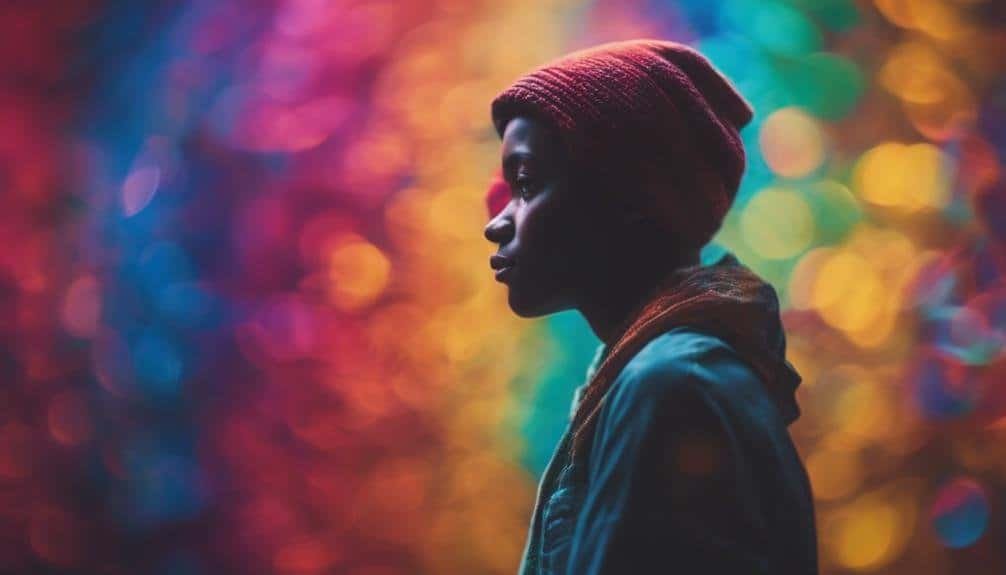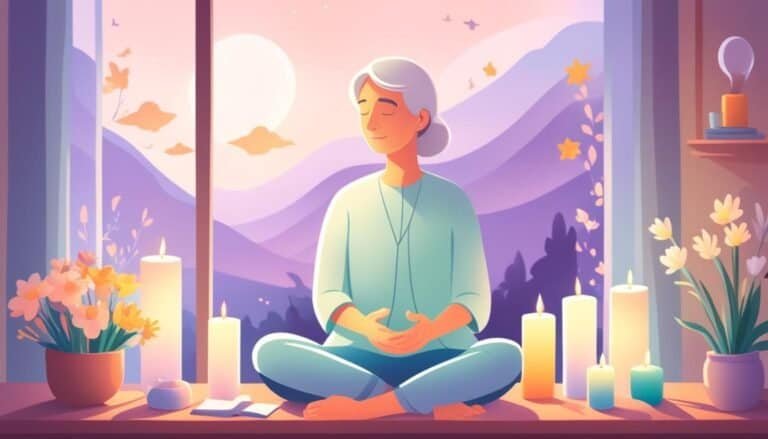The Spiritual Significance of Color and Its Impact on Our Lives
Have you ever noticed how a room painted in calming shades of blue can instantly make you feel more relaxed and at peace? Color goes beyond mere aesthetics; it can deeply impact your emotions, energy levels, and even spiritual well-being.
From ancient civilizations to modern psychology, the significance of color runs through various aspects of our lives, influencing everything from cultural beliefs to personal aura readings.
Understanding the spiritual power of color might just shed light on how you navigate the world around you and connect to a deeper sense of self.
Key Takeaways
- Colors hold deep cultural and spiritual meanings, shaping experiences and emotions.
- Different societies interpret colors with profound significance, influencing rituals and ceremonies.
- Colors resonate with energy centers in the body, promoting balance and well-being.
- Understanding color symbolism enriches cultural understanding and aids in impactful communication.
Historical Perspectives on Color
Explore the rich tapestry of historical perspectives on color to uncover the profound significance it has held throughout various cultures and civilizations. Color in art history has been a powerful tool for artists to evoke emotions, convey messages, and capture the essence of their subjects. From the vibrant hues of the Renaissance to the bold contrasts of the Baroque period, colors have played a pivotal role in shaping artistic movements and styles.
In ancient civilizations, color symbolism held deep cultural and spiritual significance. The Egyptians associated the color blue with the divine and used it in depictions of gods and royalty. The Greeks linked the color white with purity and used it in their sculptures to convey idealized beauty. Across different cultures, colors like red, symbolizing passion and essentiality, or black, representing mystery and the unknown, were used in art and rituals to express complex beliefs and societal norms.
Color Symbolism in Different Cultures
Explore the rich tapestry of cultural color meanings and the deep symbolism embedded in traditions worldwide.
Discover how different societies interpret colors and the profound significance they attribute to various hues.
Reveal the interconnectedness of global color interpretations, shedding light on the diverse ways colors shape our spiritual and cultural experiences.
Cultural Color Meanings
As we explore the domain of cultural color meanings, we uncover a rich tapestry of symbolism woven into the fabric of different societies around the world. Colors hold deep cultural associations influencing everything from fashion trends to marketing strategies. Understanding the significance of colors in various cultures can help in creating more meaningful and impactful communications. Here is a table highlighting some common cultural color meanings:
| Culture | Color Symbolism |
|---|---|
| Asian | Red for luck and joy |
| African | White for purity |
| Indian | Yellow for knowledge |
Symbolism in Traditions
Plunge into the fascinating world of color symbolism in different cultures, where hues carry profound meanings and traditions are painted with vibrant significance. Color therapy has been deeply intertwined with spiritual traditions across various cultures, each shade telling a story of spirituality and belief.
In some traditions, the color white symbolizes purity and new beginnings, while in others, red represents vitality and passion. Blue is often associated with calmness and serenity, reflecting the depths of spiritual practices. These cultural interpretations of color hold a sacred space in the hearts of many, guiding rituals and ceremonies with their rich symbolism.
Embracing the diverse meanings of colors in spiritual traditions can bring a deeper understanding of the interconnectedness between the physical and spiritual domains.
Global Color Interpretations
Plunge into the intricate tapestry of global color interpretations, where diverse cultures infuse hues with profound symbolism and meaning. Global perceptions of colors vary considerably, reflecting unique beliefs and traditions.
Here are three fascinating examples:
- Red: In many Eastern cultures, red symbolizes good luck, prosperity, and happiness. It's often worn during weddings and other joyous celebrations.
- White: While white is associated with purity and weddings in Western cultures, it signifies death and mourning in many Eastern cultures.
- Blue: Universally recognized as calming and serene, blue holds a special place in color therapy practices worldwide, believed to promote relaxation and reduce stress.
Explore how these color interpretations can enrich your understanding of different cultures and enhance your appreciation for the diverse meanings assigned to colors globally.
The Psychology of Color Perception
Exploring the psychology of color perception can provide valuable insight into the ways in which different hues evoke emotions and influence our mental processes. Color therapy, a form of alternative medicine, suggests that colors can impact our mood and well-being. Each color has a unique psychological value and can affect individuals differently. For example, red is often associated with energy and passion, while blue is known for its calming and soothing effects.
Color perception isn't only about how we see colors but also about how they make us feel. It's believed that colors can stimulate various emotions and even influence our behavior. Understanding the psychology behind color perception can help us make conscious choices about the colors we surround ourselves with.
Next time you choose a color for your living space or decide what to wear, consider the psychological effects it may have on you. By being mindful of the colors around you, you can create an environment that supports your emotional well-being and enhances your overall quality of life.
Chakras and Color Energy
As you explore the connection between chakras and color energy, you'll discover a profound interplay of spiritual and physical well-being. Understanding the symbolism each color holds for different chakras can help you align your energy centers for best flow and balance.
Investigate into the healing properties of colors to reveal the potential for transformation and harmony within yourself.
Chakras and Color Symbolism
Color plays a profound role in the intricate system of chakras, each hue resonating with specific energy centers in the body, creating a harmonious flow of vitality and equilibrium. When exploring chakras and color symbolism, it's like discovering a vibrant spectrum of spiritual understanding.
- Root Chakra (Muladhara) – Symbolized by the color red, it represents grounding, stability, and security.
- Heart Chakra (Anahata) – Radiating with green, this chakra embodies love, compassion, and healing.
- Third Eye Chakra (Ajna) – Associated with the color indigo, it signifies intuition, insight, and spiritual awareness.
Embracing these color energies can help align your chakras and nurture a deeper connection to yourself and the world around you.
Energy Flow and Balance
Achieving equilibrium and energy in your chakras involves understanding the intricate interplay of energy flow and color energy within your being. Color vibrations hold a key to releasing your spiritual connection and promoting overall well-being.
Each chakra resonates with a specific color that corresponds to its energy center, influencing your emotional and physical state. By embracing color therapy, you can enhance the balance and essentiality of your chakras, allowing for a more holistic healing experience.
Let the vibrant hues of the spectrum infuse your life with positivity and restoration. Pay attention to the colors that resonate with you, as they can help you align your chakras and restore harmony within yourself. Embrace the power of color to nurture your inner energy flow and promote a sense of wholeness.
Healing Properties of Colors
To release the profound healing properties of colors within your chakras, immerse yourself in the vibrant spectrum that resonates with your inner energy flow and promotes a sense of wholeness. Color therapy can be a powerful tool to balance and align your chakras, enhancing your overall well-being.
Here's how you can harness the healing hues:
- Root Chakra (Red): Ground yourself in the stability and security of red to strengthen your connection to the earth.
- Heart Chakra (Green): Embrace the soothing green hues to foster love, compassion, and emotional balance within yourself.
- Third Eye Chakra (Indigo): Plunge into the depths of indigo to enhance your intuition and spiritual awareness, allowing for deeper insights and clarity in your life's journey.
Healing Properties of Color Therapy
Embracing the healing properties of color therapy can bring a sense of balance and rejuvenation to your mind, body, and spirit. Color vibrations play a significant role in chromotherapy benefits, influencing your overall well-being. Each color carries its unique energy and can be used to address various physical and emotional imbalances.
Crimson, for example, is associated with vitality and courage, stimulating energy levels and promoting a sense of grounding. Lemon embodies joy and optimism, uplifting your mood and enhancing mental clarity. Emerald represents harmony and balance, fostering growth and rejuvenation. Navy is calming and promotes relaxation, aiding in stress reduction and promoting tranquility.
Color Meditation Practices
Explore the profound practice of connecting with color through meditation, allowing its vibrational energy to guide you towards inner peace and spiritual growth. Color meditation practices can be a transformative way to tune into the healing properties of color therapy and enhance your spiritual well-being.
Here are three ways to incorporate color meditation into your daily routine:
- Visualization: Start by visualizing a specific color that resonates with you. Imagine this color surrounding you, filling you with its unique energy, and bringing a sense of calm and harmony to your mind and body.
- Breathwork: As you meditate on a chosen color, focus on your breath. Inhale the color's essence, envisioning it bringing positivity and clarity into your being. Exhale any negativity or tension, allowing the color to cleanse and renew your energy.
- Mindful Coloring: Engage in mindful coloring activities where you immerse yourself in the process of coloring with intention. Choose colors that speak to your soul, and let the act of coloring become a meditative practice that promotes relaxation and self-discovery.
Aura Colors and Their Meanings
Discover the vibrant spectrum of aura colors and their profound meanings, illuminating the intricate tapestry of energies that surround and define your spiritual essence. Your aura, an energetic field surrounding your body, can be seen as different colors, each carrying unique aura interpretations and spiritual significance. These colors reflect your emotions, thoughts, and overall state of being, offering insights into your inner self. Understanding the color vibrations and energetic meanings of your aura can help you align your mind, body, and spirit.
| Aura Color | Spiritual Significance |
|---|---|
| Red | Grounded, passionate, and energetic. |
| Blue | Calm, intuitive, and spiritually connected. |
| Green | Healing, growth, and balance. |
| Yellow | Optimistic, creative, and intellectual. |
| Purple | Intuitive, mystical, and spiritually attuned. |
Each hue carries a message, guiding you on your spiritual journey. Embrace the colors of your aura and let their wisdom illuminate your path towards greater self-awareness and inner harmony.
Color in Dream Interpretation
As you navigate the vibrant tapestry of your inner world, the colors that dance in your dreams hold profound significance in guiding you towards deeper self-understanding and spiritual insight. Dream analysis and color therapy can unravel hidden messages from your subconscious, offering a window into your psyche.
Here are some ways dream colors can illuminate your spiritual journey:
- Red: In dream analysis, red often symbolizes passion, energy, and strong emotions. It may indicate a need for action or a warning to pay attention to your feelings.
- Blue: Blue in dreams is associated with tranquility, clarity, and spiritual awareness. It could signify a need for peace or a connection to higher domains.
- Yellow: Yellow represents joy, intellect, and positivity. Dreaming in yellow hues may suggest new beginnings, creativity, or intellectual pursuits.
Understanding the spiritual symbolism of dream colors can help you decipher the messages your subconscious is trying to communicate, leading to personal growth and self-discovery.
Personal Color Preferences and Personality
Personal color preferences can offer valuable insights into your unique personality traits and emotional tendencies. The colors you're drawn to can reveal a lot about who you're as a person. For example, if you find yourself constantly gravitating towards calming blues and greens, it may indicate that you're a peaceful and harmonious individual. On the other hand, a preference for vibrant reds and yellows might suggest that you're energetic and outgoing.
Our color preferences are often linked to our innermost thoughts and feelings. If you're naturally drawn to earthy tones like browns and greens, it might signify that you're grounded and connected to nature. Those who prefer pastel shades could be gentle and nurturing in their interactions with others.
Understanding your color preferences can help you gain a deeper insight into your personality traits and how you navigate the world around you. Embrace the colors that resonate with you, as they're a reflection of your inner self.
Incorporating Color Into Daily Life
If you wish to infuse more vibrancy and positivity into your daily experiences, consider embracing the power of color in your surroundings and activities. Colors have the ability to influence our moods, emotions, and energy levels, making them a valuable tool for enhancing our overall well-being. By incorporating color into your daily life, you can harness the benefits of color therapy and create a more harmonious environment for yourself.
Here are three simple ways to incorporate color into your daily practices:
- Wear colorful clothing: Start your day by choosing clothes in hues that resonate with your emotions or intentions. Bright colors like yellow can boost your mood, while blue can promote calmness and serenity.
- Create a colorful workspace: Surround yourself with vibrant artwork, stationery, or decorations in colors that inspire creativity and productivity. Consider using different colors for various tasks to enhance focus and motivation.
- Cook colorful meals: Experiment with incorporating a variety of colorful fruits and vegetables into your meals. Not only does this make your dishes visually appealing, but it also guarantees you receive a wide range of nutrients for overall health and vitality.
Frequently Asked Questions
Can Color Therapy Be Used to Treat Physical Ailments or Illnesses?
Color therapy can help with physical ailments and illnesses by harnessing the healing power of different hues. Color symbolism plays a role in this practice, offering benefits that can positively impact your well-being and overall health.
How Do Different Colors Affect Our Emotions and Mood on a Subconscious Level?
Different colors can evoke various emotions and moods on a subconscious level. Color symbolism and cultural influences play a role in how we perceive hues. Color psychology also impacts marketing strategies, influencing consumer behavior and brand perception.
Are There Specific Colors That Are More Conducive to Enhancing Creativity or Productivity?
You know how some colors just make you want to tackle that to-do list head-on while others spur your artistic side into action? Color psychology rocks in creating a vibrant, creative environment for you.
Can the Colors We Surround Ourselves With Impact Our Relationships With Others?
Surrounding yourself with specific colors can influence your relationships with others. Color psychology suggests that certain hues can impact social interactions. Understanding color symbolism can enhance your interpersonal connections, creating a more harmonious and meaningful environment.
Is There a Correlation Between Our Personal Color Preferences and Our Overall Well-Being or Mental Health?
Your personal color preferences can impact your mental health and emotional well-being. Color psychology shows that self-expression through colors can contribute to holistic healing. Embrace hues that resonate with you for a positive effect.
Conclusion
To summarize, colors aren't just hues on a palette – they hold the power to transform your world in ways you never imagined.
By understanding the spiritual significance of color and its impact on your life, you can reveal a new level of enlightenment and harmony.
Embrace the vibrant energy of colors, let them guide your emotions and thoughts, and watch as your life becomes a masterpiece painted with the beauty of the rainbow.
You're a canvas waiting to be filled with the magic of colors.






